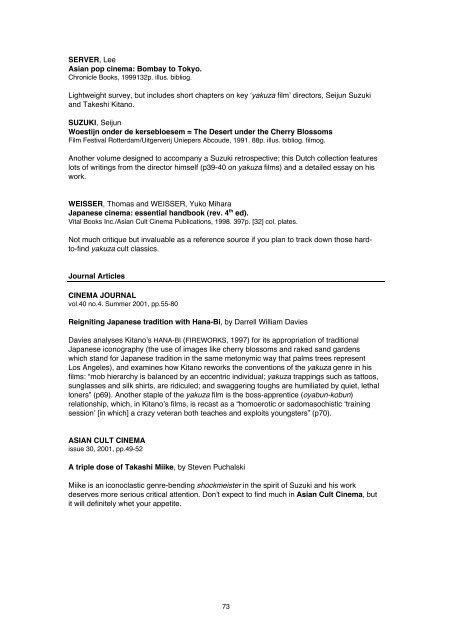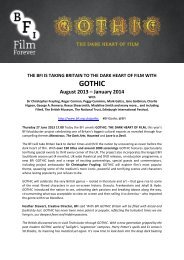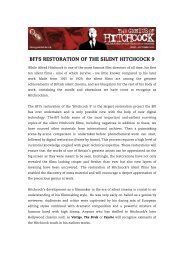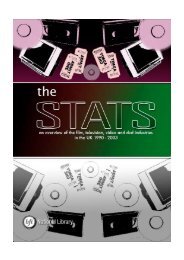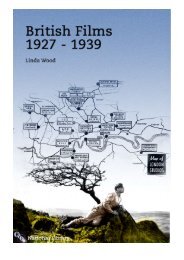16 + GUIDE - British Film Institute
16 + GUIDE - British Film Institute
16 + GUIDE - British Film Institute
Create successful ePaper yourself
Turn your PDF publications into a flip-book with our unique Google optimized e-Paper software.
SERVER, Lee<br />
Asian pop cinema: Bombay to Tokyo.<br />
Chronicle Books, 1999132p. illus. bibliog.<br />
Lightweight survey, but includes short chapters on key ‘yakuza film’ directors, Seijun Suzuki<br />
and Takeshi Kitano.<br />
SUZUKI, Seijun<br />
Woestijn onder de kersebloesem = The Desert under the Cherry Blossoms<br />
<strong>Film</strong> Festival Rotterdam/Uitgerverij Uniepers Abcoude, 1991. 88p. illus. bibliog. filmog.<br />
Another volume designed to accompany a Suzuki retrospective; this Dutch collection features<br />
lots of writings from the director himself (p39-40 on yakuza films) and a detailed essay on his<br />
work.<br />
WEISSER, Thomas and WEISSER, Yuko Mihara<br />
Japanese cinema: essential handbook (rev. 4 th ed).<br />
Vital Books Inc./Asian Cult Cinema Publications, 1998. 397p. [32] col. plates.<br />
Not much critique but invaluable as a reference source if you plan to track down those hardto-find<br />
yakuza cult classics.<br />
Journal Articles<br />
CINEMA JOURNAL<br />
vol.40 no.4. Summer 2001, pp.55-80<br />
Reigniting Japanese tradition with Hana-Bi, by Darrell William Davies<br />
Davies analyses Kitano’s HANA-BI (FIREWORKS, 1997) for its appropriation of traditional<br />
Japanese iconography (the use of images like cherry blossoms and raked sand gardens<br />
which stand for Japanese tradition in the same metonymic way that palms trees represent<br />
Los Angeles), and examines how Kitano reworks the conventions of the yakuza genre in his<br />
films: “mob hierarchy is balanced by an eccentric individual; yakuza trappings such as tattoos,<br />
sunglasses and silk shirts, are ridiculed; and swaggering toughs are humiliated by quiet, lethal<br />
loners” (p69). Another staple of the yakuza film is the boss-apprentice (oyabun-kobun)<br />
relationship, which, in Kitano’s films, is recast as a “homoerotic or sadomasochistic ‘training<br />
session’ [in which] a crazy veteran both teaches and exploits youngsters” (p70).<br />
ASIAN CULT CINEMA<br />
issue 30, 2001, pp.49-52<br />
A triple dose of Takashi Miike, by Steven Puchalski<br />
Miike is an iconoclastic genre-bending shockmeister in the spirit of Suzuki and his work<br />
deserves more serious critical attention. Don’t expect to find much in Asian Cult Cinema, but<br />
it will definitely whet your appetite.<br />
73


